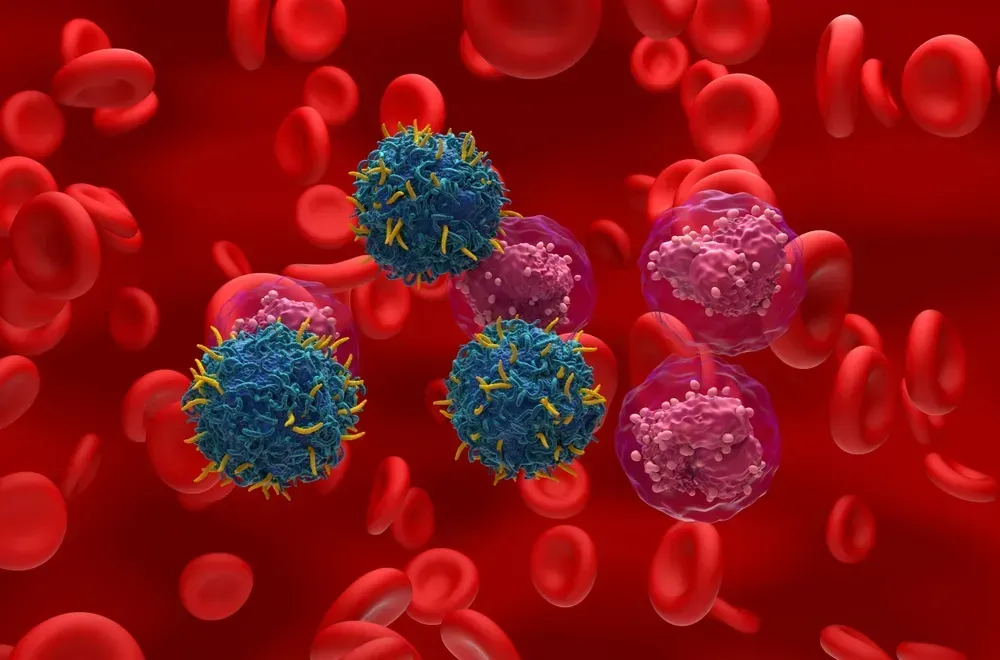What Is Multiple Myeloma?
Multiple myeloma is a blood cancer that starts with one or more changes to the DNA of a single stem cell in the bone marrow. Stem cells form blood cells (white cells, red cells and platelets).
Myeloma develops in a white blood cell called a B cell. Some B cells transform into plasma cells, which make antibodies – these are the cells that fight a wide range of infections. In myeloma, an injury to a B cell’s DNA causes an abnormal change that can start the transformation of a normal plasma cell into a cancerous cell. Because cancerous cells multiply faster than normal cells and don’t die when they should, one antibody will grow out of control and eventually crowd out other plasma cells.
If not treated, the myeloma cells can:
- Crowd out functioning white cells, and the immune system can’t guard against infection effectively
- Secrete high levels of protein in the blood and urine, which can lead to kidney damage
- Build up in bone, causing it to weaken, which can lead to bone pain and fractures
Your immune system is made up of lymphocytes (T cells and B cells) that work together to fight infections and other diseases. When B cells respond to an infection, they mature into plasma cells. Plasma cells make the antibodies (also called immunoglobulins) that help the body attack and kill germs. Plasma cells are mainly found in the bone marrow.
Bone marrow is the soft tissue inside some hollow bones. When plasma cells become cancerous and grow out of control, they can produce a tumor called a plasmacytoma. These tumors generally develop in a bone but are rarely found in other tissues. If there is only a single plasma cell tumor, it is called an isolated (or solitary) plasmacytoma. When there is more than one plasma cell tumor, it is called multiple myeloma.
Early Presentations and Signs of Multiple Myeloma
Early signs and symptoms of multiple myeloma might look like other health issues.
Here are some examples of what myeloma symptoms could look like in your body:
- Bone problems or bone breakages from a minor stress or injury
- Weakness in the spine, severe pain, numbness, and/or muscle weakness due to bone lesions
- Anemia due to low blood counts
- Frequent thirst, along with frequent urination and potential dehydration, due to high blood calcium
- Severe constipation and loss of appetite due to high blood calcium
- Decreased kidney function caused by the myeloma protein or kidney failure due to high blood calcium
- Frequent infections due to low levels of healthy blood cells.
For more information about multiple myeloma signs and symptoms, check out this page: What Are Signs and Symptoms of Multiple Myeloma?
How Long Will I Live with Multiple Myeloma?
If you have been diagnosed with multiple myeloma, it is normal to wonder how long your life expectancy could be.
Advancements in treatment options have improved outcomes for many patients. While multiple myeloma is generally considered incurable, many people manage the disease and live relatively normal lives for an extended period of time. A multiple myeloma diagnosis is no longer a death sentence.
To read more about what can influence your prognosis with multiple myeloma, read here: What is the Prognosis of a Multiple Myeloma Patient?
Stay Informed with HealthTree Myeloma News
Explore the latest multiple myeloma news, including patient stories, treatment breakthroughs, and expert insights so you can make confident, informed decisions.
Multiple myeloma is a blood cancer that starts with one or more changes to the DNA of a single stem cell in the bone marrow. Stem cells form blood cells (white cells, red cells and platelets).
Myeloma develops in a white blood cell called a B cell. Some B cells transform into plasma cells, which make antibodies – these are the cells that fight a wide range of infections. In myeloma, an injury to a B cell’s DNA causes an abnormal change that can start the transformation of a normal plasma cell into a cancerous cell. Because cancerous cells multiply faster than normal cells and don’t die when they should, one antibody will grow out of control and eventually crowd out other plasma cells.
If not treated, the myeloma cells can:
- Crowd out functioning white cells, and the immune system can’t guard against infection effectively
- Secrete high levels of protein in the blood and urine, which can lead to kidney damage
- Build up in bone, causing it to weaken, which can lead to bone pain and fractures
Your immune system is made up of lymphocytes (T cells and B cells) that work together to fight infections and other diseases. When B cells respond to an infection, they mature into plasma cells. Plasma cells make the antibodies (also called immunoglobulins) that help the body attack and kill germs. Plasma cells are mainly found in the bone marrow.
Bone marrow is the soft tissue inside some hollow bones. When plasma cells become cancerous and grow out of control, they can produce a tumor called a plasmacytoma. These tumors generally develop in a bone but are rarely found in other tissues. If there is only a single plasma cell tumor, it is called an isolated (or solitary) plasmacytoma. When there is more than one plasma cell tumor, it is called multiple myeloma.
Early Presentations and Signs of Multiple Myeloma
Early signs and symptoms of multiple myeloma might look like other health issues.
Here are some examples of what myeloma symptoms could look like in your body:
- Bone problems or bone breakages from a minor stress or injury
- Weakness in the spine, severe pain, numbness, and/or muscle weakness due to bone lesions
- Anemia due to low blood counts
- Frequent thirst, along with frequent urination and potential dehydration, due to high blood calcium
- Severe constipation and loss of appetite due to high blood calcium
- Decreased kidney function caused by the myeloma protein or kidney failure due to high blood calcium
- Frequent infections due to low levels of healthy blood cells.
For more information about multiple myeloma signs and symptoms, check out this page: What Are Signs and Symptoms of Multiple Myeloma?
How Long Will I Live with Multiple Myeloma?
If you have been diagnosed with multiple myeloma, it is normal to wonder how long your life expectancy could be.
Advancements in treatment options have improved outcomes for many patients. While multiple myeloma is generally considered incurable, many people manage the disease and live relatively normal lives for an extended period of time. A multiple myeloma diagnosis is no longer a death sentence.
To read more about what can influence your prognosis with multiple myeloma, read here: What is the Prognosis of a Multiple Myeloma Patient?
Stay Informed with HealthTree Myeloma News
Explore the latest multiple myeloma news, including patient stories, treatment breakthroughs, and expert insights so you can make confident, informed decisions.
Trending Articles
Upcoming Events
Get the Latest Multiple Myeloma Updates, Delivered to You.
By subscribing to the HealthTree newsletter, you'll receive the latest research, treatment updates, and expert insights to help you navigate your health.
Together we care.
Together we cure.
3x Faster.







